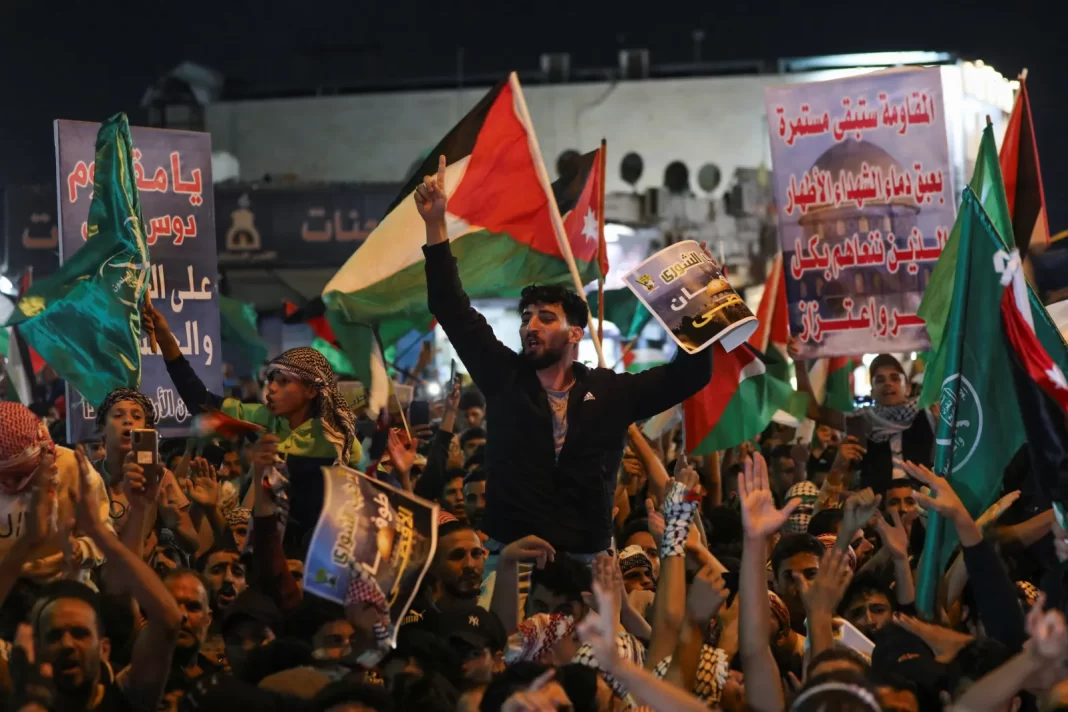The Rationality of The Summit… The Brutality of Arms… And The Discourse of Resistance
Nadim Koteich/Asharq Al-Awsat/November 14/2023
عقلانية القمة… ووحشية السلاح… وخطاب «الممانعة»
نديم قطيش/الشرق الأوسط/الثلاثاء 14 تشرين الثاني/2023
في النسيج المعقد لسياسات الشرق الأوسط، تقاطعت 3 تطورات، يسلط كل منها الضوء على تعقيدات اللحظة الراهنة في مسار الصراع الفلسطيني- الإسرائيلي، والديناميات الإقليمية الأوسع المرافقة له. فمن ناحية هناك القمة العربية الإسلامية، ببيان ختامي لافت؛ لا سيما في حضور الرئيس الإيراني، ومن ناحية ثانية هناك التقدم العسكري الإسرائيلي في غزة الذي خالف التوقعات بخصوص كلفته الإسرائيلية، وثالثاً هناك التهافت المريع الذي بدا عليه خطاب محور المقاومة، ممثلاً بحسن نصر الله، في ضوء المآسي النازلة بالمدنيين الفلسطينيين.
نجحت القمة العربية الإسلامية في إقرار بيان ختامي يعكس إلى حد بعيد أولويات محور التعقل والاعتدال العربي، في مقاربة القضية الفلسطينية، على الرغم من حضور الرئيس الإيراني شخصياً إلى المملكة. اللافت في البيان الختامي، بعيداً عن النقاط الأساسية والكلاسيكية في مواجهة تطورات أمنية وعسكرية مماثلة، أن البيان أدان بلغة واضحة «قتل المدنيين»، وأن «لا فرق على الإطلاق بين حياة وحياة، أو التمييز على أساس الجنسية أو العرق أو الدين». فهذا الموقف عدا كونه موقفاً مبدئياً متجذراً في القيم الإنسانية والقانون الدولي، فإنه ينطوي على إدانة ولو غير مباشرة لعملية «حماس» يوم السابع من أكتوبر (تشرين الأول) الماضي، والتي أدت إلى سقوط عدد كبير من الضحايا المدنيين الإسرائيليين. ويعد هذا الموقف المتقدم رافداً مهماً للموقف العربي الذي يؤكد الحاجة إلى التدخل الفوري لحماية المدنيين الفلسطينيين.
الخلاصة الرئيسية الثانية التي خرجت بها القمة هي إعادة التأكيد على «منظمة التحرير الفلسطينية» باعتبارها الممثل الشرعي والوحيد للشعب الفلسطيني. تؤكد هذه النقطة ضرورة توحيد الفصائل الفلسطينية جميعها تحت مظلة «منظمة التحرير الفلسطينية»، بغية إنتاج جبهة فلسطينية متماسكة، لا بديل عنها لتحصين الموقف الوطني الفلسطيني. مهما بدا هذا الكلام مملاً، فإنه يبقى المسار الوحيد المثمر للفلسطينيين، والنقيض الموضوعي لمسار الانقسام بين غزة والضفة بمآلاته المأساوية الراهنة.
أما النقطة الثالثة في البيان فهي التأكيد على الالتزام بالسلام خياراً استراتيجياً للعرب، مع التركيز بشكل خاص على حل الدولتين والمبادرة العربية للسلام 2002 أساساً لجهود السلام الشامل والعادل.
أهمية هذه النقاط الثلاث أنها تسترد قيادة الموقف من الصراع الإسرائيلي- الفلسطيني، وتحميها من أفخاخ المزايدات؛ لا سيما أنها أُقرت في ظل إجماع عربي وإسلامي، وبالارتكاز إلى مرجعيات موقف الاعتدال العربي الذي حاولت إيران وغيرها ضربها لحساب موقف يعتمد أكثر على خطاب المقاومة والكفاح المسلح.
وفي هذا السياق، بدا خطاب المقاومة ممثلاً بخطاب حسن نصر الله شديد الارتباك حيال تطور الأحداث الدموية في غزة. فبينما الفلسطينيون يُقصفون بأعنف ما شهدته الحروب السابقة مجتمعة، ويُفرض عليهم النزوح عن ديارهم، بشكل مهين، تسلح حسن نصر الله، نيابة عن المحور، بسيل من الكلام المكرر حول «الإنجازات» المتمثلة بصاروخ هنا ومُسيَّرة هناك، بينما الدبابات الإسرائيلية تسرح في وسط شمال غزة.
لقد أدخل هذا الخطاب الفلسطينيين في دوامة دمار ورعب لا يمكن تخيلهما، نتيجة التجاهل المَرضي لاختلال توازن القوى مع إسرائيل، وعدم تهيئة الساحة الفلسطينية وتزويدها بما يعينها على تحمل أكلاف الحرب. وقد أدى هذا النهج إلى مشاهد الدمار والتهجير، مما سلط الضوء على عواقب الاستراتيجية التي يبدو أنها تفتقر إلى البصيرة والواقعية.
أما على الجانب الإسرائيلي، وخلافاً للتوقعات التي رجحت فشل التوغل العسكري في غزة، والحديث عن احتمال ارتفاع التكاليف البشرية في صفوف الجيش، حقق الأخير تقدماً كبيراً داخل القطاع، واستعاد كثيراً من السمعة التي تبددت نتيجة عملية 7 أكتوبر الماضي. بيد أن هذا النجاح العسكري الإسرائيلي، حتى الآن، يبدو فاقداً بالكامل لأي أفق سياسي أو دبلوماسي يحدد ماهية المسار المستقبلي من وجهة نظر إسرائيل.
أمام هذه الوقائع الثلاث: مقررات القمة العربية الإسلامية، والموقف الإسرائيلي، وخطاب محور المقاومة، يرتسم موقف معقد يعاني من 3 انسدادات خطيرة.
فالقمة العربية الإسلامية تمتلك خطة سياسية واضحة ومتماسكة؛ لكنها تفتقر للأنياب الضرورية لفرضها مساراً واقعياً وعملياً لإنهاء النزاع.
أما الموقف الإسرائيلي لحكومة بنيامين نتنياهو فكله أنياب؛ بلا أي ليونة سياسية أو مخيلة براغماتية قادرة على تطوير شيء مشترك، مع الفلسطينيين أولاً ومع الدول العربية ثانياً، بغية وضع حد لهذه السلسلة المتوالية من الأزمات.
ويبقى خطاب محور المقاومة الذي يأسر المخيلة الشعبية مستفيداً من هول العذابات الفلسطينية، من دون أن يمتلك القدرة على المقاومة التي ترد عن الفلسطينيين جحيمهم الراهن، أو النبل لتنقية المناخ السياسي من المزايدات والانفعالات والميدانيات التي تعطل الحلول السياسية وتؤجل وقف المعاناة الفلسطينية.
The Rationality of The Summit… The Brutality of Arms… And The Discourse of Resistance
Nadim Koteich/Asharq Al-Awsat/November 14/2023
Three recent intertwined developments that makeup part of the intricate tapestry of Middle Eastern politics shed light on the current complexities of the Palestinian-Israeli conflict and its broader regional dynamics. First, we have the joint Arab-Islamic Summit, which ended with a noteworthy final communique, especially given the attendance of the Iranian President. Second, the Israeli army has made significant progress in Gaza, with the low costs incurred by Israel defying expectations. Thirdly, amid the suffering of Palestinian civilians, the discourse of the Resistance Axis has become dreadfully incoherent, as seen in the speech of Hassan Nasrallah.
Despite the personal attendance of the Iranian President, the joint Arab-Islamic Summit held in the Kingdom managed to release a final communique that largely reflects the objectives of the Arab axis of moderation regarding the Palestinian question. Beyond the basic and classic responses to security and military developments of this kind, the statement notably explicitly condemned “the killing of civilians” and affirmed “the absolute equivalence of every single life, rejecting any discrimination based on nationality, race, or religion.”
In addition to being a principled position rooted in humanitarian values and international law, this stance implicitly condemns the Hamas operation on the seventh of October that resulted in a large number of Israeli civilian casualties. This position provides crucial support for the Arab position, which stresses the need for immediate intervention to protect Palestinian civilians.
The second key aspect of the communique is that it reaffirmed that the Palestine Liberation Organization is the sole legitimate representative of the Palestinian people. This assertion underscores the need to bring all the Palestinian factions together under the umbrella of the PLO, in order to ensure the cohesion of the Palestinian front, which is the only way to strengthen the Palestinian national position. As tedious as this rhetoric may seem, this remains the course that could yield results for the Palestinians, and it is objectively antithetical to the current split between Gaza and the West Bank.
Third, the statement asserts that commitment to peace is a strategic choice the Arabs have made, putting particular emphasis on a two-state solution and the 2002 Arab Peace Initiative as the basis for a comprehensive and just peace.
These three assertions are significant because they reclaim the leading position of the Arabs in setting the tone for stances on the Israeli-Palestinian conflict and protect it against insidious posturing. Moreover, these points are particularly consequential given the fact that the communique of Arab and Islamic based on pillars of the position of the moderate Arab states, which Iran and others have sought to undermine in favor of the discourse of resistance and armed struggle, was ratified by consensus.
On the other hand, the discourse of resistance regarding the violent developments in Gaza as we saw in Hassan Nasrallah’s speech, seems incoherent. While the Palestinians were facing bombardment in greater intensity than all of the previous wars combined and forced to flee their homes in humiliation, Hassan Nasrallah, on behalf of the Resistance Axis, armed himself with a stream of repetitive rhetoric about “achievements” amounting to a missile here and a drone there in the face of Israeli tanks roaming freely in central and northern Gaza.
This discourse has left the Palestinians caught in an unimaginable spiral of destruction and terror because of its pathological disregard for the imbalance of power vis a vis Israel and a failure to do the bare minimum to equip the Palestinian arena to bear the costs of war. This approach has led to the scenes of devastation and displacement we are seeing, highlighting the consequences of a strategy that lacks foresight and realism.
On the Israeli side, defying expectations that the military incursion into Gaza would fail and that the war would take a heavy toll on the army, it has made significant progress, making up for much of the reputational damage it suffered after the October 7th operation. However, from the future of Israel’s perspective, no Israeli political or diplomatic horizons have arisen despite this success on the ground thus far.
We are faced with these three realities: the resolutions of the Arab-Islamic Summit, the Israeli stance, and the discourse of the Resistance Axis. They create a complex situation picture that leaves three serious impasses.
The Arab-Islamic Summit has presented a clear and coherent political initiative. However, it lacks the force needed to impose a realistic and practical path for ending the conflict. On the other hand, the Israeli government of Benjamin Netanyahu has nothing but brute force; it lacks the political flexibility or pragmatic imagination needed to build common grounds, firstly with the Palestinians and secondly with the Arab states, upon which an end to this continuous series of crises could be built.
Finally, we have the discourse of the Resistance Axis, which has captivated the popular imagination by capitalizing on the horrors of the Palestinians’ suffering. However, this discourse is not backed by the capabilities needed for the kind of resistance that could save Palestinians from the hell they currently find themselves in. It also lacks the integrity needed to purify the political scene from emotional reactions hindering political solutions and delaying an ending to the Palestinians’ suffering.





















